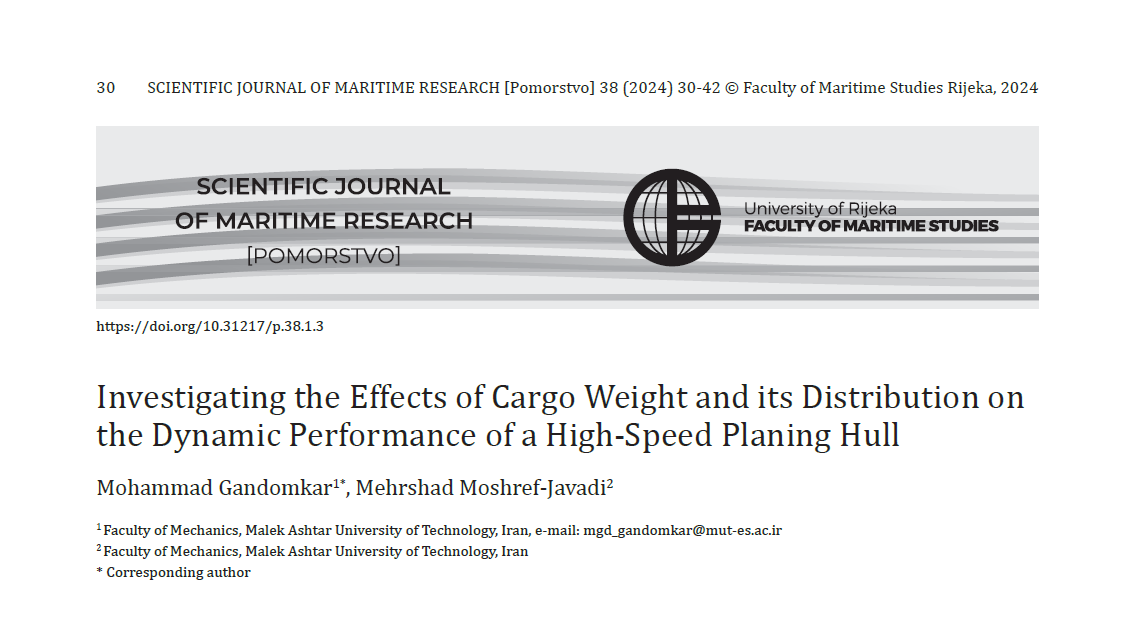Investigating the Effects of Cargo Weight and its Distribution on the Dynamic Performance of a High-Speed Planing Hull
Keywords:
High speed planing hull, Heave, Pitch, Cargo weight, Load distribution, WavelengthAbstract
The aim of this article is to evaluate the effects of cargo relative weight and its distribution along the boat’s length in addition to the relative water wavelength on the dynamic performance of a high-speed planing hull. Here, the dynamic performance is measured by the intensity of the boat’s heave and pitch motions. The Zarnick’s strip theory, which divides the vessel’s hull into equal lateral sections, is used to study the applied forces on the vessel, and a MATLAB code is provided based on it. It is demonstrated that increasing the cargo weight and its distribution result in more heave and pitch, and the maximum amount of them are observed in the wave with a length of about 5 times the length of the boat. In addition, the interactive effects of cargo weight and its distribution on the heave and pitch motions are affected by the relative wavelength. Therefore, the more centralized cargo distribution is preferred to increase the dynamic performance of a heavy planing boat with cargo weights more than 50% of the boat’s weight, while moving in short waves (λ⁄L<4); and for light cargo weight, less than 50% of the boat’s weight, the favorite cargo distribution is broad. When the boat sails in long waves, the desired distribution is reversed.

Downloads
Published
Issue
Section
License
Copyright (c) 2024 Mohammad Gandomkar, Mehrshad Moshref-Javadi

This work is licensed under a Creative Commons Attribution-NonCommercial-NoDerivatives 4.0 International License.
Scientific Journal of Maritime Research understands the need for authors to disseminate and maximize the impact of their research. When submitting an article for publishing in Scientific Journal of Maritime Research, it implies that the Corresponding Author transfers, with the consent of all Coauthors, the copyright ownership in the referenced submission, including all versions in any format now known or hereafter developed, to the Scientific Journal of Maritime Research.
Copyright protects your original work and research material and prevents others from using it without your permission. Others will be required to credit you and your work properly, thus increasing its impact. Should your submission be rejected or withdrawn prior to acceptance for publication by Scientific Journal of Maritime Research, this transfer will be null and void.
Authors, users or readers of an article need clear instructions on how they can use the article. Scientific Journal of Maritime Research uses the Creative Commons Attribution-NonCommercial-NoDerivatives (CC-BY-NC-ND) 4.0 International License, which governs the use, publishing and distribution of articles by authors, publishers and the wider general public.
The authors are allowed to post a digital file of the published article, or the link to the published article (Scientific Journal of Maritime Research web page) may be made publicly available on websites or repositories, such as the Author’s personal website, preprint servers, university networks or primary employer’s institutional websites, third party institutional or subject-based repositories, and conference websites that feature presentations by the Author(s) based on the published article, under the condition that the article is posted in its unaltered Scientific Journal of Maritime Research form, exclusively for non-commercial purposes.




